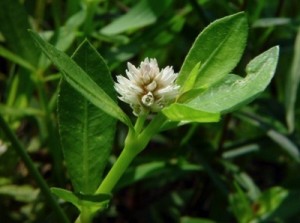Alternanthera philoxeroides: Exotic Munch
If you have alligators you have alligator weed. That’s a little odd because alligator weed is a native of South America where there are no alligators. But now Alligator Weed is found in the same waters as alligators, and many other places as well.
Introduced into the United States around 1894, it is an invasive weed in many states. It’s also a little-known edible though it is in the amaranth clan. One place it is eaten a lot is Burma but it does come with a warning.
One PhD expert says raw it tastes better than many salad greens and some in a salad is fine. In other words, when green it can be a garnish or a salad addition. Another says more than 100 grams dry weight ( 3.5 oz dry, which probably translates into a half a pound or more wet weight) might provide too much calcium oxalate, a bad dose. The point is don’t dry it and eat 3.5 ounces of it. Some raw in your salad is fine. Also cooking can reduce the calcium oxalate in greenery.
The botanical name, Alternanthera philoxeroides, means “alternate flower like the philoxerus.” It is said alter-NANTH-er-uh fil-oh-zer-OY-deez, or Alter-ann-THER-rah fie-lox-er-OH-deez. And indeed it does resemble the philoxerus but that is now called the Blutaparon vermiculare, which only grows near salt water. The A. philoxeroides can tolerate some brackish water.
There are many Alternanthera in warmer areas so key out the plant carefully. A. philoseroides is the most common. Four known edibles are A. ficoidea, A sessilis, A. sissoo, and A. versicolor. A. sessilis is well-distributed in the U.S., A. ficoieda is rare. A. versicolor is found in Asia. A sissoo is a common green in South America but must be cooked.
Green Deane’s “Itemized” Plant Profile
Identification
“A. philoxeroides: A perennial herb; stems creeping or floating, ascending towards apex, rooting at the lower nodes, branched, hollow, with a longitudinal hairy groove on 2 opposite sides. Leaves subsessile or with petiole to 5 mm long, with a ring of white hairs between the 2 opposite leaf bases. Lamina 3-13 x 1-3.5 cm, elliptic to oblanceolate or obovate, glabrous or slightly hairy near the attenuate base; apex obtuse or acute. Inflorescences in upper axils, mostly 1-2 cm in diameter, capitate, white; pedicles to 9 cm long with 2 opposite longitudinal hairy grooves, occasionally heads shortly pedunculate and terminal. Bracts 2.5-3.5 mm long, ovate-acuminate; bracteoles similar to bracts, somewhat smaller, persistent. Tepals 5-7 mm long, oblong to ovate, acute or obtuse. Fertile stamens 5; staminodes = stamens. Style short, thick; stigma capitate.” (Webb et al, 1988; p. 101).
Time Of Year
Nearly year round
Environment
In fresh water, or on damp land, can also tolerate some brackish water.
Method Of Preparation
Leaves in small amounts raw, also as a cooked green.


